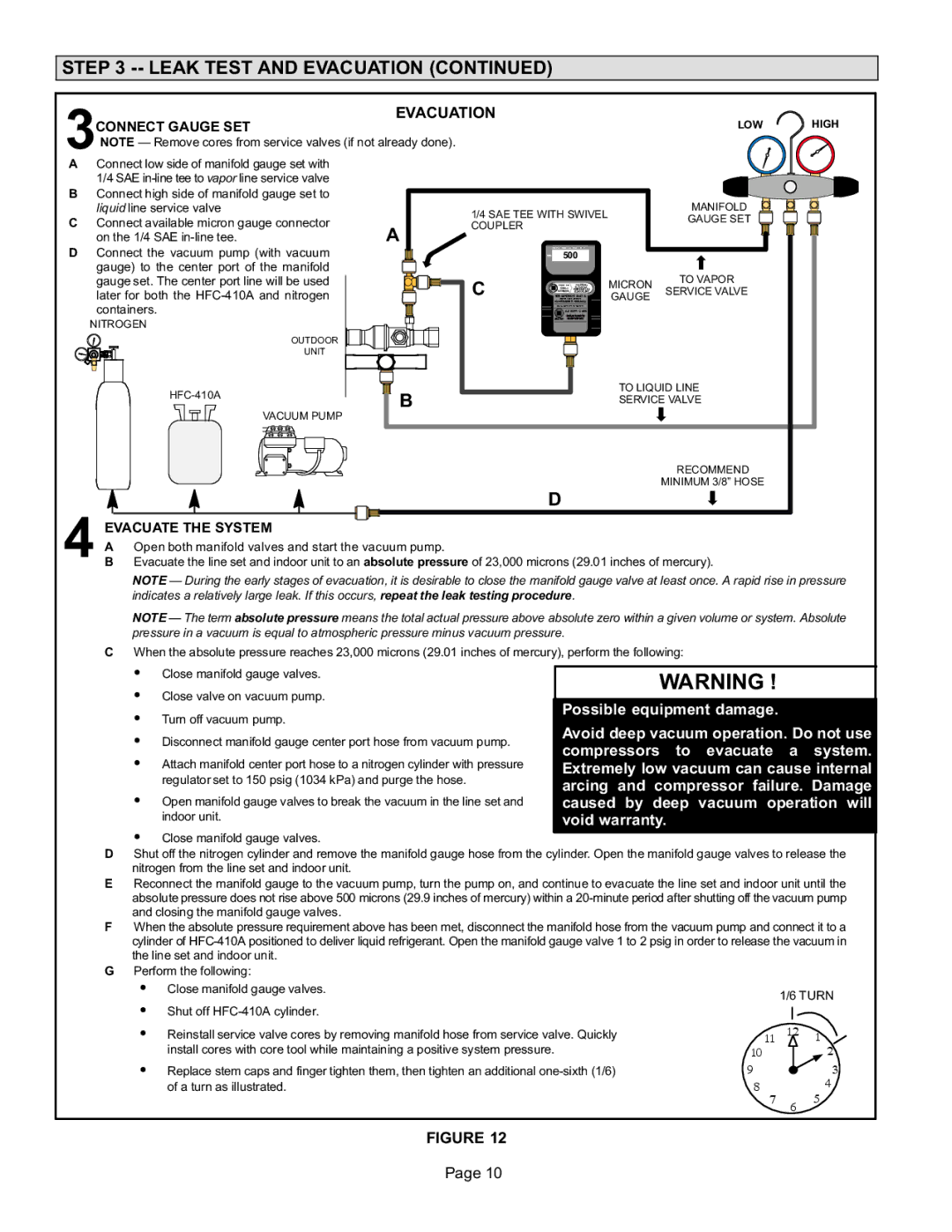
STEP 3 -- LEAK TEST AND EVACUATION (CONTINUED)
3 | EVACUATION | HIGH |
CONNECT GAUGE SET | LOW |
NOTE — Remove cores from service valves (if not already done).
AConnect low side of manifold gauge set with 1/4 SAE
BConnect high side of manifold gauge set to liquid line service valve
CConnect available micron gauge connector on the 1/4 SAE
DConnect the vacuum pump (with vacuum gauge) to the center port of the manifold gauge set. The center port line will be used later for both the
containers.
NITROGEN
OUTDOOR
UNIT
VACUUM PUMP
| 1/4 SAE TEE WITH SWIVEL |
| MANIFOLD |
|
| GAUGE SET | |
| COUPLER |
| |
A |
|
| |
|
|
| |
| 500 |
|
|
| C | MICRON | TO VAPOR |
| SERVICE VALVE | ||
| GAUGE | ||
|
|
|
B | TO LIQUID LINE | |
SERVICE VALVE | ||
|
RECOMMEND
MINIMUM 3/8” HOSE
D
EVACUATE THE SYSTEM |
4 A Open both manifold valves and start the vacuum pump. |
BEvacuate the line set and indoor unit to an absolute pressure of 23,000 microns (29.01 inches of mercury).
NOTE — During the early stages of evacuation, it is desirable to close the manifold gauge valve at least once. A rapid rise in pressure indicates a relatively large leak. If this occurs, repeat the leak testing procedure.
NOTE — The term absolute pressure means the total actual pressure above absolute zero within a given volume or system. Absolute pressure in a vacuum is equal to atmospheric pressure minus vacuum pressure.
CWhen the absolute pressure reaches 23,000 microns (29.01 inches of mercury), perform the following:
S Close manifold gauge valves. | WARNING ! | ||
S | Close valve on vacuum pump. | ||
| |||
S | Turn off vacuum pump. | Possible equipment damage. | |
| |||
S | Disconnect manifold gauge center port hose from vacuum pump. | Avoid deep vacuum operation. Do not use | |
compressors to evacuate a system. | |||
S Attach manifold center port hose to a nitrogen cylinder with pressure | |||
Extremely low vacuum can cause internal | |||
| regulator set to 150 psig (1034 kPa) and purge the hose. | ||
| arcing and compressor failure. Damage | ||
S |
| ||
Open manifold gauge valves to break the vacuum in the line set and | caused by deep vacuum operation will | ||
| indoor unit. | void warranty. | |
SClose manifold gauge valves.
DShut off the nitrogen cylinder and remove the manifold gauge hose from the cylinder. Open the manifold gauge valves to release the nitrogen from the line set and indoor unit.
EReconnect the manifold gauge to the vacuum pump, turn the pump on, and continue to evacuate the line set and indoor unit until the absolute pressure does not rise above 500 microns (29.9 inches of mercury) within a
FWhen the absolute pressure requirement above has been met, disconnect the manifold hose from the vacuum pump and connect it to a cylinder of
GPerform the following:
SClose manifold gauge valves.
SShut off
SReinstall service valve cores by removing manifold hose from service valve. Quickly install cores with core tool while maintaining a positive system pressure.
SReplace stem caps and finger tighten them, then tighten an additional
| 1/6 TURN | |
11 | 12 | 1 |
10 |
| 2 |
9 |
| 3 |
84
7 6 5
FIGURE 12
Page 10
